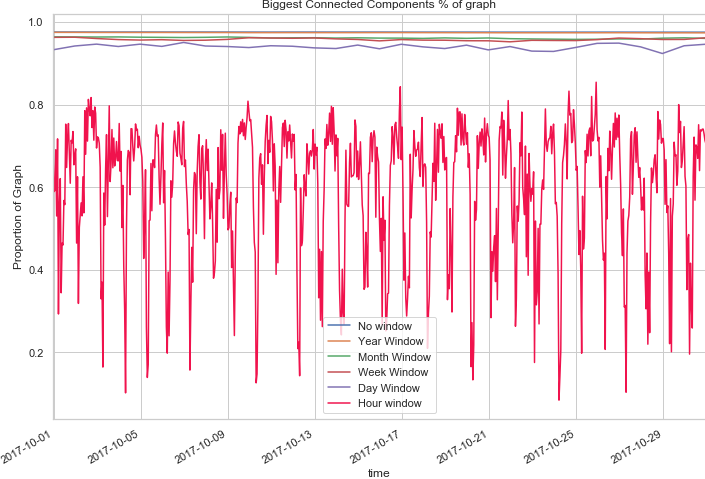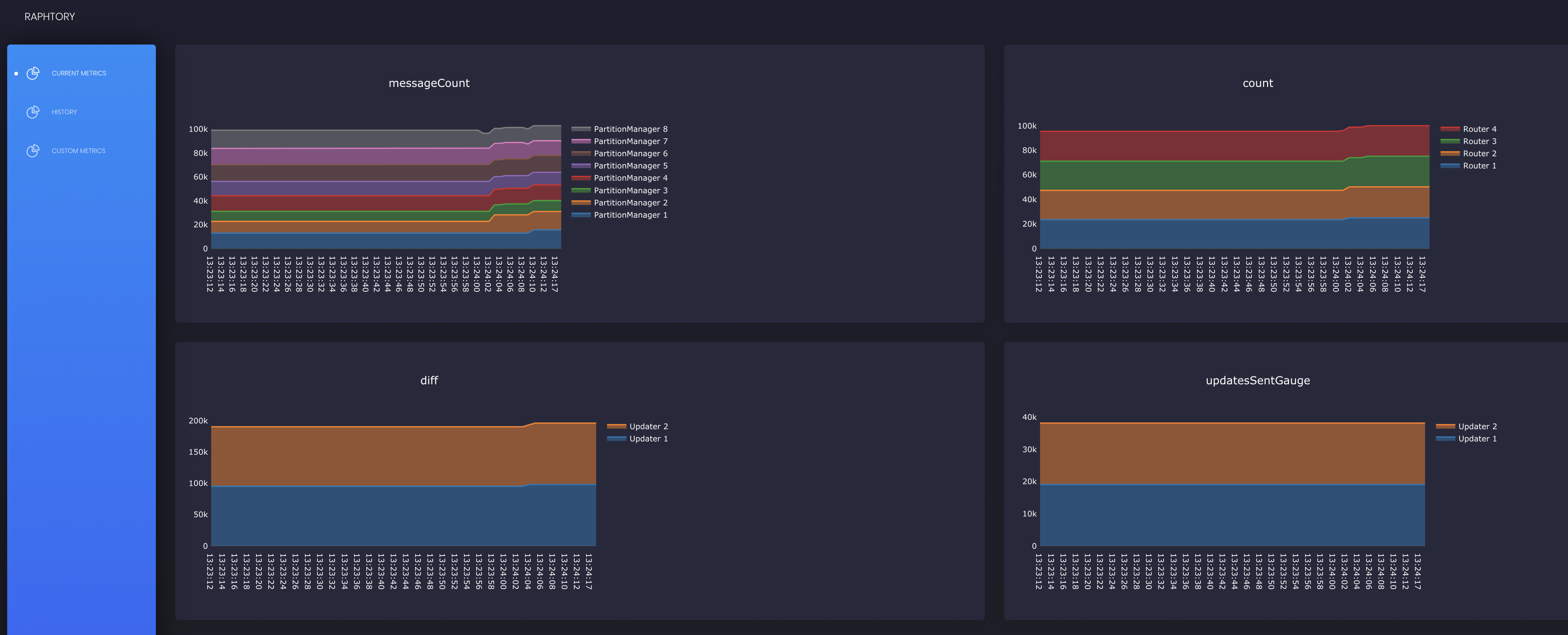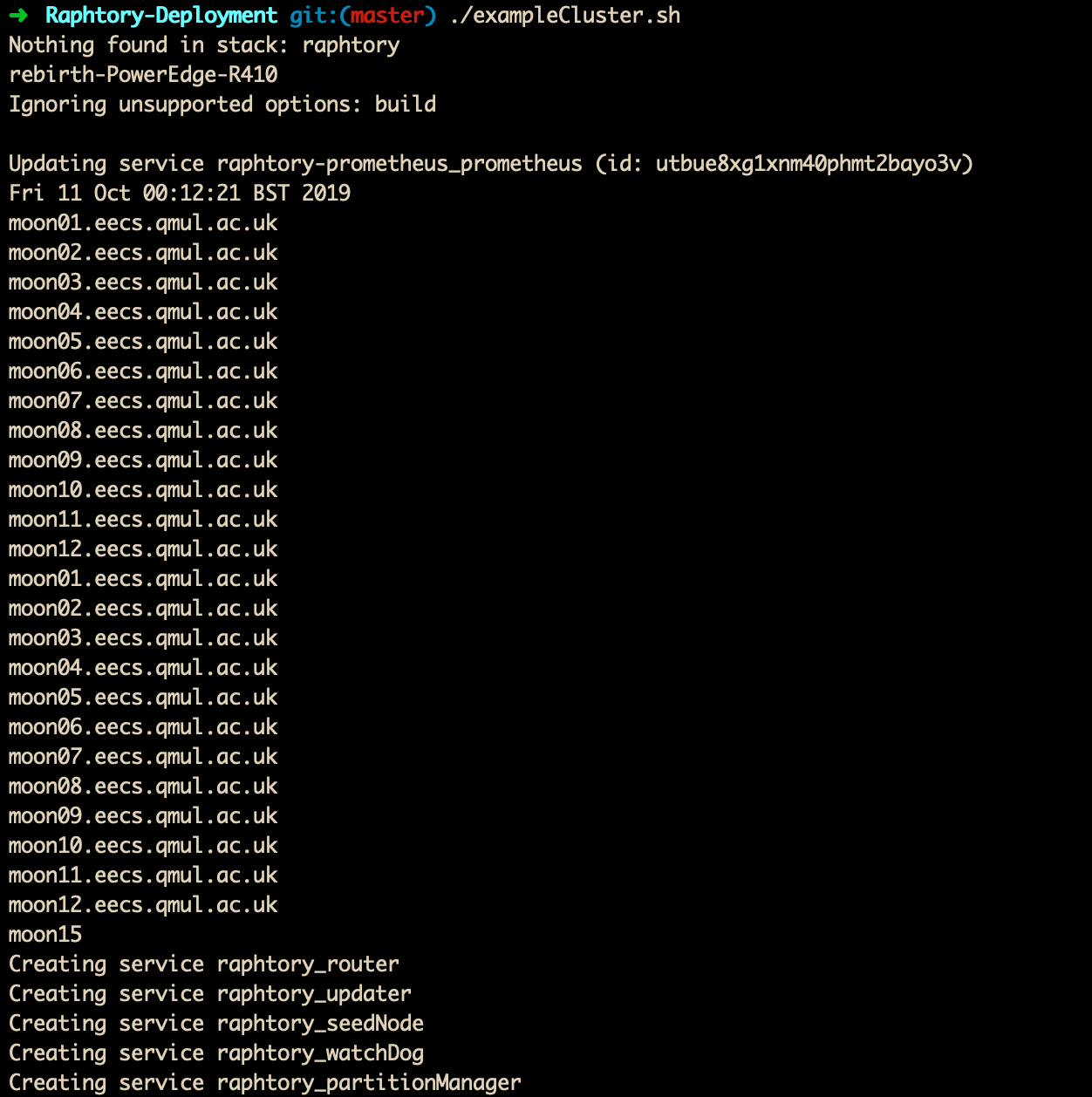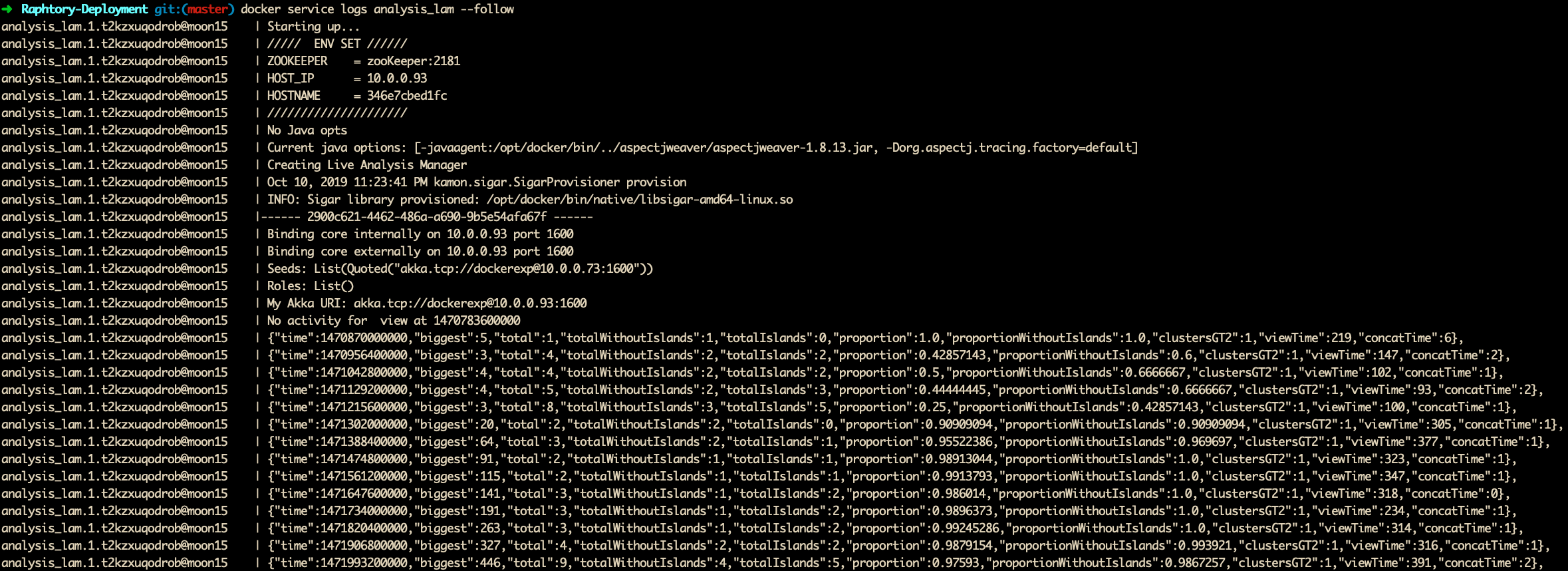Raphtory is an ongoing project to maintain and analyse temporal graphs built from event streams within a distributed environment. The most recent article on Raphtory can be found here. Alternatively if you cannot access this science direct version a draft PDF can be found here.
Raphtory is built around the actor model using the Akka Framework. There are four main Actor types: Spouts, Routers, Partition Managers and Analysis Managers.
Spouts attach to a source in the wild such as a Kafka Stream or Rest API, ingesting this data and sending it to the Routers. Routers take this raw data from the given source and convert it to Graph updates via user defied functions. These updates may consist of adding or removing Vertices and Edges or updating their properties. Routers then send these updates to the Partition Manager responsible for the affected entities who will insert it into an ordered history. If the Partition manager is not in charge of all effected entities (such as an edge which spans between two Vertices which are stored in different partitions) it will communicate with other partitions to synchronize the update across the cluster. As Raphtory inserts updates into an ordered history, and no entities are actually deleted (just marked as deleted within their history) the order of execution does not matter. This means that Addition, Deletion and Updating are all addative opperations which can be carried out in any order and still end up with the same graph. Analysis Managers may then freely connect to the cluster at run time requesting different types of analysis to take place.
An overview of this can be seen in the diagram below:
Analysis in Raphtory is split into three different types: Live, View and Range. Live Analysis runs on the most up-to-date version of the graph including all updates as they arrive. View Analysis allows the user to pick any point within the ingested history and process the graph as it looked at that exact point in time by filtering out vertices/edges which did not exist then and setting properties to the values they had at the provided time. Range Analysis expands upon views by taking a start point, end point and interval, hoping forward through time between these points, building graph views at each increment and performing the desired analysis. The output of this allows the user to see how a given property like Average Degree or Connected Components changes throughout the graphs lifetime.
Raphtory also allows users to set a window time of interest so that only vertices/edges within the last hour/day/month etc. are included in the analysis, ensuring users avoid missing interesting patterns which may be prevelant in the short term, but covered up by years of older events. Windowing may be run on Live, View and Range queries and may also be done with batches of windows.
As an example of this, below are two plots from a range query on the GAB.AI graph (build from user interactions within the social network). The Analyser was looking at different features of connected components between August 2016 and May 2018, hoping forward one hour at a time. For each view the analysis was completed with windows of one year, month, week, day,and hour to see how the extracted properties would change. (This is all run in one job).
The first plot looks at the largest component size. Within this, the Month and week windows show several intersting upticks in user activity which slowly drops back down, a trend not easy to see within the year window. Similarly within the second plot, which looks at the proportion of the graph the largest component consists of, for all windows greater than an hour almost 100% of the users are connected. At the hour window, however, this varies wildy throughout the day (between 10% and 80%) as the communities go to sleep and wake back up. The data and notebook for these plots can be found here.
To run Raphtory please refer to the Raphtory-Deployment repository.
To make Raphtory as easy to run as possible it has been containerised within docker. This means that you only have to install docker and you will be able to run raphtory on your machine.
First clone the Raphtory-Deployment project which contains all of the docker-compose(yml) files required for running. Docker-Compose files specify which containers to run, how many of each type and what ports to open etc. Within the Raphtory-Deployment repository there are three main compose files: One for running a Raphtory cluster, one for performing analysis and a third for lanching Prometheus which is the monitoring tool that Raphtory reports to. There is also a forth compose file which combines all of these into a single node for running locally.
Once Docker is setup you may pick an example workload to experiment with. There are three to choose from (see here): A 'random' graph where updates are generated at runtime; the GAB.AI graph (a graph build from the posts on the social network); and a 'coingraph' built by ingesting the transactions within the bitcoin blockchain.
Each datasource comes with a Spout which generates/pulls the raw data, a Router which parses the data into updates, and example Analysers which perform some basic processing; a selection of which can be found here. Note: Both GAB and Bitcoin workloads have example data baked into Raphtory's base image, meaning you can run these without having access to the GAB rest API, or a Bitcoin full node established.
Raphtory uses Reflection to decide what Spout/Router/Analyser to create at run time. Therefore, to choose one of these examples you do not need to rebuild the Raphtory image, only change the docker environment file (.env) which docker stack requires when running. Example .env files are available here for each of the workloads.
For the insturctions below I shall be using the GAB data and readme example environment file which have several scripts to automate your first run of Raphtory.
To run locally a script is provided which carries out all the steps required to get our node up and running. This copies the example environment file to .env and then writes the parameters of your query into it. This script takes several arguments:
- The first being the type of analaysis you would like to perform; Live View or Range.
- The second parameter is then the analysis you would like to perform (ConnectedComponents is currently the only tested on on this version)
- If you have chosen live analysis the third and forth parameter are the type of windowing [false,true or batched] and the size of the window in milli seconds (a comma seperated list if batched).
- If instead you are doing a view or range this would then be the chosen view time/start end and interval followed by the chosen window. These must be given in unix timestamps.
This will run Live Analysis on the Graph as it is ingested, without any windowing:
./raphtoryLocal.sh Live ConnectedComponents false This will run a view query at Thursday, 29 September 2016 02:03:44 with a window of one day:
./raphtoryLocal.sh View ConnectedComponents 1475114624000 true 86400000This will run a range query between august and october doing connected componnents every hour with window sizes of one hour, day, week, month and year similar to the one run for the plots above:
./raphtoryLocal.sh Range ConnectedComponents 1470783600000 1476114624000 3600000 batched 31536000000,2592000000,604800000,86400000,3600000When the script begins you will see the initial logs prometheus and raphtory tagged and coloured by who sent them:
Once everything has booted up the Analysis Manager will kick in and begin reporting back to the terminal the results of the Queries. Alongside results here, you may also see messages saying there was no activity within the set window/view combination (as at the top of the figure below) or alternativly if the analysis has gotten ahead of the ingestion a backoff message informing the user that the analysis (as at the bottom of the figure):
In this instance the data that is being output specifies the time the analysis took place (i.e. the view), how large the window was and then metrics that seemed interesting for Connected Components: Biggest Component, Total components, Biggest components proportion of the graph etc. If you are interested in seeing how this output comes to be, you can check the algorithm here.
{
"time": 1514502000000,
"windowsize": 2592000000,
"biggest": 22046,
"total": 589,
"totalWithoutIslands": 283,
"totalIslands": 306,
"proportion": 0.9600662,
"proportionWithoutIslands": 0.9730326,
"clustersGT2": 32,
"viewTime": 12056,
"concatTime": 2
}If you have selected a Range or View query once the query has been completed Raphtory will close down and report a success to the user. If you have chosen Live analysis this will continue to run forever until the user decides to stop it. In either case, once you are happy that the example has run its course you can take down Raphtory by pressing ctrl+c:
Whilst the analyis is running you may access the Prometheus interface at localhost:8888 which logs many interesting metrics from Akka, the JVM and Raphtory. This is also a timeseries database so you can see how these metrics are changing as the ingestion/analysis progresses.
Alongside the default interface we are also developing a Raphtory dashboard, which will report on things such as current ingestion by each Partition Manger/Router and current size of the Graph/History range in-memory etc. This is a work in progress, but can be accessed at localhost:8888/consoles/site/html/dashboard.html:
Running on a cluster is similar to the local deployment, but utilises Docker Swarm instead of Docker-compose. A Docker Swarm cluster can be setup running docker swarm init, this will then provide a join command to be run on any node that you want to join the swarm as a worker. Once you have done this on all of your nodes you can then run docker node ls on your manager node to get a list of all workers (below is the cluster I will be using for this demo):
As swarm doesn't really have a fantastic way to pick which nodes a service is run on, we manage this via node labels. For this example (and all the scripts available) this is done via our node lists directory which you will have to set depending on your cluster nodes and choice of components. For the example I will split the above nodes into 8 Partition Managers, 4 routers, 1 for Prometheus (The master node) and 1 for misc components (watchdog, seednode, updater and analysis manager). As a minimum you need one node for each of these services, or have change the yml files to say place Partition Managers and Routers on the same machines. You can also add all of your nodes to nodes.list and the labels will be refreshed each run.
Once you have this conf all setup, you can establish the raphtory cluster with ./examplecluster.sh, which will remove any old raphtory instances, allocate labels and build all required services:
We can then view the output from any of these services via: docker service logs raphtory_XXX --follow where the XXX is replaced with the service name such as raphtory_partitionManager.
If you are happy that these are all working you can then connect an Analysis Manager, which works in exactly the same way as the local script, for example:
./exampleAnalysis.sh Range ConnectedComponents 1470783600000 1476114624000 86400000 false 86400000
The Analyser is then run on a seperate stack so that it can be brought up an down independently. The output from this can be viewed by docker service logs analysis_lam --follow:
Once you have finished with the chosen query the Analysis Manager can be brought down with docker stack remove analysis and new queries can be run with ./exampleAnalysis.sh. Finally when you are happy everything is working, the cluster can be removed by running:docker stack remove raphtory.











